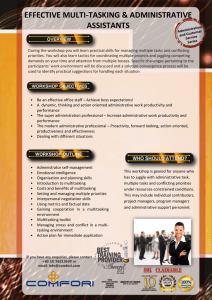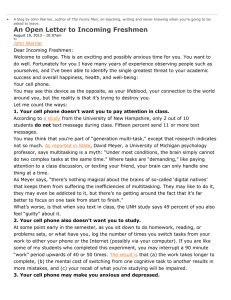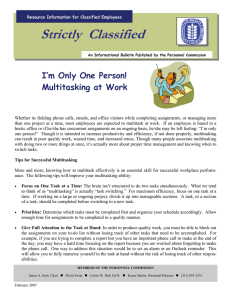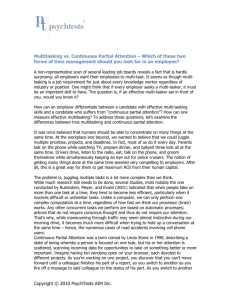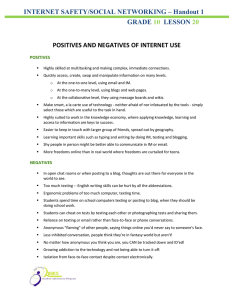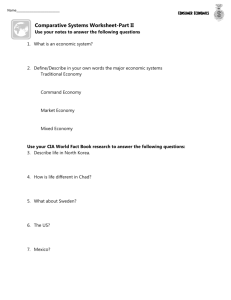Control Freaks How Online and Mobile Communication is Reshaping Social Contact
advertisement
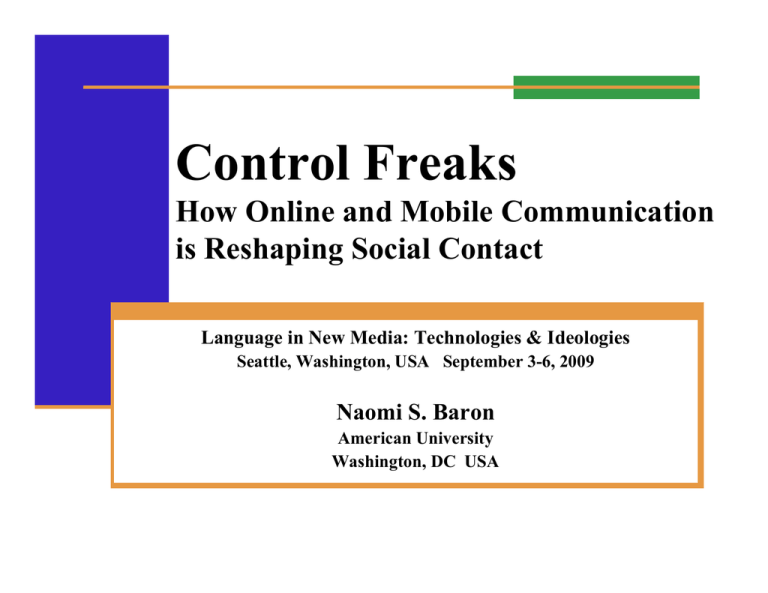
Control Freaks How Online and Mobile Communication is Reshaping Social Contact Language in New Media: Technologies & Ideologies Seattle, Washington, USA September 3-6, 2009 Naomi S. Baron American University Washington, DC USA In the Beginning… 2 Consequences of Technology Switching functions Steam engines: pumping water out of mines (Thomas Newcomen and John Calley, 1712) Mainframe computers: fighting wars, crunching numbers Photo caption: November 21, 1950, Princeton, NJ: “A new type of electronic brain that will save years of time and millions of dollars in the design and construction of guided missiles, ships, planes and submarines” The internet: communicate in time of war Late 1960s: develop decentralized computer system to transmit information across the US in case of nuclear attack 3 Consequences of Technology Unintended consequences Discovery of oil as fuel: Manufacture of computers: unending war in the Middle East toxic waste Manufacture of mobile phones: depletion of rare metals 4 Consequences of Earlier Language Technologies Printing press Spread of literacy Rise of Protestantism Eventual spelling standardization Telegraph Origin of Associated Press Effect on American writing style (Hemingway) Telephone No written record for shady business deals Speaker phone function Answering machines 5 Consequences of Online and Mobile Language Technologies What kinds of technologies are we talking about? Common assumptions about effects of these technologies Alternative argument 6 Technologies at Issue Online (computer-based) Email IM (instant messaging) Blogs SNS (social networking sites) e.g., Facebook, MySpace, Twitter Mobile (phone-based) Voice Text (e.g., texting, email, IM, blogs) 7 Common Assumptions about Effects of New Language Technologies A “new” language exists Alternative names proposed include Electronic language, e-style, email/IM/texting lingo, netspeak “New” language is characterized by Abbreviations (e.g., b4), acronyms (e.g., ttyl), random spelling and punctuation “New” language threatens “standard” language 8 Alternative Argument The primary effects of online and mobile language technologies are not upon our language but upon our social interactions 9 Overview of Lecture Myths and half-truths about online and mobile language Controlling linguistic interaction Traditional methods Control via online and mobile technologies American University Cross-Cultural Mobile Phone Study Multitasking as a form of control Consequences of controlling the conversation What – if anything – should be done? 10 Myths/Half-Truths about Online/Mobile Language: Electronic Language Myths A single e-style exists that people use consistently That style is having deleterious effects on offline language Reality Online and mobile language varies across people, across media, and across audiences Effects of online/mobile language on offline language are minimal, e.g., A few acronyms entering speech and writing (lol, brb, ttyl) Reinforcement of diminished attention to spelling, punctuation Bottom line We know how to style shift (Pew Internet & American Life study) We generally rise to the linguistic standards set for us 11 Myths /Half-Truths about Online/Mobile Language: Emoticons (= smileys) Myths Reality Online communication is inherently prone to misunderstanding, and emoticons make up for loss of face-to-face cues When smileys and frownys were created by Scott Fahlman in 1982, at Carnegie-Mellon, few people communicated via computer, and text production was awkward The university-based tech community engaged in much online joking and sarcasm Written language in general lacks face-to-face cues, and we cope through clarity of expression Bottom line A few emoticons (smiley, frowny, winky) are now common As online/mobile communication becomes commonplace, we feel less need for emoticons 12 Controlling Linguistic Interaction History of control in communication Crossing the street to avoid conversation Letters: answering at leisure (or ignoring) Landline phones: speaker phones, answering machines 13 Online Technologies: More Opportunities for Controlling Linguistic Interaction Blocking people/appearing invisible On IM On Facebook Forwarding messages Ignoring messages Multitasking while doing IM (stay tuned) 14 Mobile Technologies: More Opportunities for Controlling Linguistic Interaction Caller ID “It’s only Mom” Choosing whether to reply to (even listen to) voicemail TrapCall (for Do Not Receive list): “The number you have called is no longer in service” Fake Calls (iPod application): “Have you ever been in the situation where you need the perfect excuse to get out of the room or step out of an annoying conversation?” ID Spoofing Bogus caller ID, voice changer 15 American or Global? How much is use of technology to control linguistic interaction an American – or an international – phenomenon? Charting usage patterns and attitudes American University Cross-Cultural Mobile Phone Project 16 American University Cross-Cultural Mobile Phone Project Goal of study Understand the factors shaping mobile phone usage by university students in different parts of the world Factors included: culture, cost, prior familiarity with technology, gender, age Probed what commonalities transcend culture Caveats Difficulty of separating nation from culture Difficulty in disaggregating variables (e.g., cost vs. culture) 17 Design of Study Countries Sweden, US, Italy, Japan, and Korea Subjects c. 2000 university students, aged 18-24 Study methods Online survey (c. 10 minutes) Scalar, numerical answers Open-ended answers Focus groups (Sweden, US, Italy, Japan) Time-frame October 2007 – December 2008 18 Components of Online Survey Demographic information Questions about mobile phone and computer use (compare texting and IM) Frequency with which talk, text on mobile phone Reasons for talking versus texting Attitudes towards using mobile phones in public space (e.g., with friends at coffee shop, walking down the street, on a subway) Pretending to use phone to avoid social contact Open-ended questions 19 Open-Ended Questions Word association task ( = free response) What are the first three (3) words you think of when you think of mobile phones? Two most important uses of mobile phone besides talking and texting How has usage changed over past three years? Like most / like least What is the one thing you like most about having a mobile phone? Like least? 20 Sample Cultural Findings Swedish subjects Most comfortable talking on phone in public space (at café with friends, on a bus, walking down the street) American subjects Heavily evaluative (positively and negatively), including complaints about other people being loud on phones Italian subjects Many complaints about cost (but: family-based explanation) Japanese subjects Most likely to talk about internet functions on mobile phone; many complaints about poor keitai manners Korean subjects Heaviest users of both talking and texting 21 Key Questions Involving Control Scalar Use of IM (on computer) vs. texting (on mobile phone) Reasons for deciding to talk vs. send a text message Pretending to talk on mobile phone (or fiddling with other functions) to avoid conversation with an acquaintance a stranger Word Association What are the first three words you think of when you think of mobile phones? Open-ended What is the one thing you like most about your mobile phone? What is the one thing you like least about your mobile phone? 22 IM (computer) vs. Texting (mobile phone) More IM on Computer More Texting on Mobile Sweden 55% 45% US 42% 58% Italy 28% 72% Japan 6% 94% Korea 9% 91% NOTE: In all countries, males were more likely to “do more IM on computer” than were females; texting on mobile affords more control (asynchronous medium) than IM on computer (synchronous medium) 23 Talking vs. Texting: Volume (how many calls/texts sent/received previous day -- estimate) 0-4 5-10 ≥11 Sweden voice text 62% 56% 32% 31% 6% 13%* (0%) (1%) US voice text 49% 40% 38% 27% 13% 33% (1%) (11%) Italy voice text 79% 33% 19% 27% 2% 40% (0%) (17%) Japan voice text 85% 18% 13% 30% 2% 52% (1%) (16%) Korea voice text 48% 4% 35% 15% 17% 81% (2%) (44%) (≥30) NOTE: Because of rounding, not all rows sum to 100%. 24 Talk or Text? Text to Keep Message Short Very Important Somewhat Important Total Sweden 34% 40% 74% US 38% 34% 72% Italy 35% 36% 71% Japan 13% 31% 44% Korea 11% 37% 48% NOTE: In all countries, responses were largely similar between males and females 25 Pretending to Talk: Avoiding Acquaintances, Strangers “At least once a month” Acquaintances Sweden Strangers 4% 4% US 13% 15% Italy 2% 8% Japan 6% 6% Korea 9% 9% 26 Fiddling with Other Functions: Avoiding Acquaintances, Strangers “At least once a month” (e.g., check email, play game) p=pretend to Acquaintances Strangers Sweden 15% (p. talk: 4%) 18% (p. talk: 4%) US 25% (p. talk: 13%) 26% (p. talk: 15%) Italy 8% (p. talk: 2%) 13% (p. talk: 8%) Japan 21% (p. talk: 6%) 25% (p. talk: 6%) Korea 20% (p. talk: 9%) 22% (p. talk: 9%) NOTE: In Sweden, “strangers don’t come up to you”; Italy as a “public culture” in which even strangers are part of same space 27 Word Association: Three Words Coding Overall rankings Importance of communication Issues linked to control Positive evaluation Negative evaluation 28 Coding Categories for “3 Words” MAJOR CATEGORY SAMPLE SUBCATEGORIES Technology issues named telecommunications carrier (e.g., Sprint, Vodafone), miscellaneous telecommunications words (e.g., carrier, subscription) Physical attributes/ functions names for handset (e.g., cell phone, telephone), physical phone components (e.g., battery, keypad), size (e.g., bulky, slim), phone number (e.g., address book), ancillary functions (e.g., clock, games, ring tones, graphic images, organizer, internet, television, time tables, web dating service) Communication contact (e.g., in touch, reachable), spoken language (e.g., chat, call), texting (e.g., text, SMS), social community (e.g., boyfriend, family), etiquette (e.g., manners, priority seat), bridge distance (e.g., far away friends, to travel), emotions (e.g., affection, quarrels) 29 Coding Categories (continued) MAJOR CATEGORY SAMPLE SUBCATEGORIES Positive evaluation mobility (e.g., car, portability), speed (e.g., fast, quick contact), planning (making plans), overall positive judgment (e.g., best friend, good to have), independence (e.g., autonomy) Negative evaluation addiction/dependency (e.g., addictive, slavery), disruption (e.g., interruption, intrusive), stress/anxiety (e.g., angst, stress), evil/crime/danger (e.g., crime via internet, hazardous site), bad manners (e.g., breach of manners, nuisance on a train), equipment/transmission problems (e.g., dead battery, lost, static) Cost issues value-neutral (e.g., bill, SIM card), expensive (e.g., costly, ripoff, wasted money) Safety issues general (safe, security), emergencies (e.g., emergency situation), radiation-related concerns (e.g., brain tumor) Advertising e.g., commercial, advertisement on SMS 30 Overall Rankings: Importance of Communication Sweden US 48% 42% Selected Subtotals: Texting: 17% Total: Talking: 9% Italy Japan Korea 52% 42% 49% 14% 21% 29% 25% 11% 10% 2% 15% 31 Positive and Negative Evaluation Sweden US Italy Positive: Negative: 10% 4% 18% 8% 15% 4% Examples: Positive: Negative: indispensable, die without it, best friend addiction, stress, time-consuming, annoying Japan Korea 18% 7% 11% 2% NOTE: Most frequent positive evaluation in US and Japan was “easy/convenient” Most frequent negative evaluation in US was “annoying/bother” but in Japan was “addiction/dependency” 32 Like Most about Mobile Phone Sweden US Italy Japan Korea 59% 58% 46% 28% Communication subcategories texting: 12% 6% talking: 0% 0% 8% 0% 7% 0% 4% 0% Communication 77% (highest category) 33 Like Least about Mobile Phone Sweden US Italy Japan Korea 49% 44% 27% 42% Communication subcategories texting: 1% 3% talking: 0% 0% 3% 0% 5% 0% 3% 1% Other categories/subcategories dependency: 6% 7% obligation to respond: 11% 9% equipment/transmission: 13% 16% cost: 10% 11% 9% 4% 5% 14% 10% 4% 20% 18% 31% 1% 3% 6% Communication (highest category) 48% 34 Examples of “Obligation to Respond” (Like Least) “That other people know I can always be reached. So you can never say that you couldn’t take the call because everyone knows that you can see missed calls” (Swedish female) “That others can control you and believe you must always be accessible” (Italian female) “No excuse for not talking to people that I don’t want to talk to” (American male) “To be always retraceable, so much so that at home I put [my mobile phone] in a lead box to avoid being traced (so it does not signal that it is off, but not reachable)” (Italian male) 35 Reachability: Reanalyzing Like Most/Like Least Reachability = I reach others, others reach me, directionality of contact unspecified Sweden US Italy Japan Korea Like most: 88% 83% 69% 65% 76% Like least: 57% 57% 52% 37% 72% 36 Summarizing Control Findings from Mobile Phone Study Choosing to text (not do IM on computer or talk on mobile) Pretending to talk, fiddling with phone to avoid conversation Three words (stress, addiction) Like most/like least (communication conundrum) Reachability (communication conundrum) 37 Multitasking as a Form of Control How is multitasking a form of control? Multitasking in everyday life Types of multitasking Literature on multitasking Multitasking while doing IM Multitasking while face-to-face 38 How is Multitasking a Form of Control? Time management Social management Alleviating boredom “I’d feel really bored if I were only doing one thing at a time” [on the prospect of only conducting one IM conversation at a time]: “That would be too weird” 39 Multitasking in Everyday Life Walking down the street and whistling a tune Being a short-order cook Making supper while helping children with homework Playing the violin / organ Driving a car 40 Types of Multitasking Cognitive multitasking Issue: mental consequences of doing more than one thing at a time NOTE: term “multitasking” also used for Seriatim tasks (e.g., work on math problem, then read passage, then return to math problem) Interruptions more generally (e.g., work on a document, stop to check travel website, return to document) Social multitasking Issue: social effects of doing more than one thing at a time 41 Literature on Multitasking Good news: brain change is possible London taxi drivers: larger posterior hypocampus Bad news: poor performance is most common result Psychological literature Nearly always shows degradation of performance Glenn Wilson (HP) study: when IQ test taken in presence of distractor (e.g., ringing phone), score fell average of 10 points Industry literature Microsoft: employees sidetracked from work an average of additional 10-15 minutes when interrupted by another task Linda Stone: “continuous partial attention” life as a “never-ending cocktail party where you’re always looking over your virtual shoulder for a better conversational 42 partner” Multitasking while Doing IM American University study (2004-2005) Sample multitasking activities while doing IM Web-based activities: 70% Word processing: 39% Face-to-face conversation: 41% Averaged 2.7 simultaneous IM conversations range: 1-12 20% multitasked while using computers because they were bored Complaints about Others Doing Multitasking “People on the phone with you get pissy about hearing the keyboard clicking” “Talking on the phone and [simultaneously] talking to people on the computer [i.e., IM] isn’t appropriate because the person on the other phone line usually feels left out or unattended to” 43 Multitasking while Face-to-Face Alone Together Acceptable to talk on mobile phone when with friends at an informal café? American college students: 23% said “yes” Swedish college students: 43% said “yes” HP Study (2005): Hypocrisy? “90% of office workers judged that colleagues who responded to emails or text messages during a face-to-face meeting were being rude” However, 1 out of 3 of same respondents indicated such behavior was both acceptable and an efficient use of time 44 Cognitive Aside: Downside of Multitasking Stanford Study (2009) Ophir, Nass, and Wagner (PNAS August 24) College undergraduates who engaged in a lot of media multitasking (e.g., computer video, music, computer games, telephone voice or texting) were worse at ignoring distractors or at task switching than students who were light multitaskers i.e., practice at multitasking doesn’t improve performance 45 Consequences of Controlling the Conversation Legitimizing a mentality of social avoidance and social control Potential devaluation of relationships Potential diminution of social skills NOTE: Social capital studies (e.g., Barry Wellman): being online doesn’t mean having fewer face-to-face interactions US General Survey: reduction in number of very close friends (online/mobile technologies: may feed social isolation, but no evidence they are the source) Beware of assumption that “world is only now going to pieces” 46 Remedies? Personal choices Opting out of technologies Giving up social networking sites (including: giving up Facebook for Lent) Not using/not turning on mobile phone BUT: then you become a problem to others Central dictates No computers in classroom (counterintuitive?) Redefining social ethos Analogy: Sweden Walk (not take elevator); shame of failing to recycle Reshape social expectations for use of ICTs 47 Thank you Naomi S. Baron American University Washington, DC nbaron@american.edu Always On: Language in an Online and Mobile World (2008, Oxford University Press) 48
